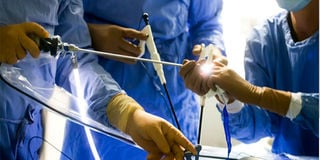Appendicitis requires immediate medical care

Laparoscopy involves making a small cut on your abdomen through which surgical instruments are inserted. Photo | surgerytime.com
What you need to know:
- Each day, her pain worsened until she went to hospital. Here, after a physical examination by exerting pressure on her lower abdomen on the right side of the belly button, the doctor suspected she might have an infection in the appendix.
Although Stella Ngonzi had appendicitis, the pain she felt was first confused with sciatica (pain that travels along the path of the sciatic nerve which travels from the lower back through the hips and buttocks and down each leg.
Each day, her pain worsened until she went to hospital. Here, after a physical examination by exerting pressure on her lower abdomen on the right side of the belly button, the doctor suspected she might have an infection in the appendix.
She was given antibiotics but after a month of taking them, the pain worsened and her general health deteriorated. At the hospital, an abdominal scan was recommended.
"The results showed an inflamed appendix which meant I was suffering from appendicitis. The doctor recommended surgery to remove the appendix," she says.
After the surgery, she was advised to eat more fruits and avoid hard to digest foods. She was also cautioned against lifting heavy items and after about a month, she resumed working.
What is appendicitis?
This is the inflammation of the last part of the large intestine known as the appendix. The inflammation or infection is caused by an accumulation of faecal matter that lodges in this narrow tube located on the lower right side of the abdomen.
According to Dr Deo Lukyamuzi Kizza, a gastroenterologist at Case Hospital in Kampala, usually, faeces can go into it and then come out. However, if the bowel movements are for any reason slowed down, the faecal material may not come out of the appendix.
“The water contained therein keeps getting absorbed from the faecal material just like any other part of the long intestine. With time, the faecal material becomes harder, forming stone-like particles that accumulate over time cutting off the blood supply. The blockage then becomes infected with bacteria, causing inflammation in the area,” he remarks.
The inflammation can progress into death of tissue cells in that area and one can get a perforation through the appendix. This condition must be treated as a medical emergency because in left untreated, with time, the infection can burst with the infected content spreading into the abdominal cavity.
Signs and symptoms
According to Dr Lukyamuzi, the classical presentation of appendicitis is characterised by on and off pain around the umbilicus. This dull or sometimes sharp pain settles in the lower right side of the abdomen and can worsen when you walk. It is also characterised by diarrhea, fever, vomiting and pain that spreads to all parts of the abdomen.
When the pain spreads, the body tries to contain it but without treatment, it increases and one can develop pus (appendicular abscess), which causes a mass in the appendix.
Diagnosis
With the above symptoms, the doctor will take your medical history, do a physical examination by exerting a little pressure on the right side of your lower abdomen. A full blood count (CBC) may reveal an increased white blood cells count but the abdominal scans can be of help to give a confirmatory diagnosis.

"There is usually pain and tenderness at the location of the appendix. With this, we recommend an ultrasound (CT) scan of the abdomen, and this is the standard diagnostic test for appendicitis," Dr Lukyamuzi says.
Treatment
Once caught in the early stages, doctors can use conservative methods to treat the condition. Here, the patient may be prescribed painkillers and antibiotics. If there is no improvement or relief from the pain, after about six weeks, surgery to remove the appendix must be done.
In most cases of appendicitis, the appendix needs to be surgically removed as soon as possible. The appendix has lymph node tissues and, therefore, protects the body from infections. There are other body parts with a similar function and having it removed does not cause any health problem.
“The most preferable type of operation is the keyhole surgery (laparoscopy) because here, recovery is quicker and leaves a small scar. The surgery involves making a small cut on your abdomen through which special surgical instruments are inserted. A small tube with a light and a camera are inserted into a small incision that is made on the abdomen and these relay images of the inside of the abdomen to a monitor,” Dr Lukyamuzi says.
Small surgical tools are used to remove the appendix and once this is done, the incision is closed with dissolvable or regular stitches and after about a week, the latter can be removed by your surgeon or a general practitioner. Depending on where you have this surgery done in Uganda, the cost may range between Shs4.5m to Shs7m.
Open surgery
If a patient has had an open abdominal surgery or when the appendix has already burst and formed a lump (appendix mass), keyhole surgery is not recommended. Here, open surgery is the option
During open surgery, a larger cut in the lower right-hand side of the abdomen is made. This type of surgery is also carried out if the appendix has burst or access is more difficult. This may cost between Shs500,000 and Shs3.5m.
It may take some time for complete recovery from an appendectomy and usually, strenuous activities should be avoided for up to six weeks after open surgery.
“In both cases, the part that is removed is usually sent for further tests to rule out cancer. Therefore, when you get unexplained pain in the abdomen, it is important that you seek medical attention and avoid self-medication,”Dr Lukyamuzi cautions.
Recovery
Although keyhole surgery is expensive, it is more preferable since recovery time tends to be shorter and the patient can leave hospital a few days after the operation (sometimes within 24 hours).
However, with open surgery, it may take up to a week before you are well enough to go home. In the first days after the operation, you may experience some pain and the doctor may prescribe painkillers if necessary.
The doctor will also advise you on how to care for the wound before you are discharged and you will be warned against strenuous activities that exert pressure on the wound.
You may experience some short-term constipation after the surgery but Stella Ngozi remarks that she was advised to stay hydrated, eat foods containing fibre as well as plenty of fruits and vegetables.




